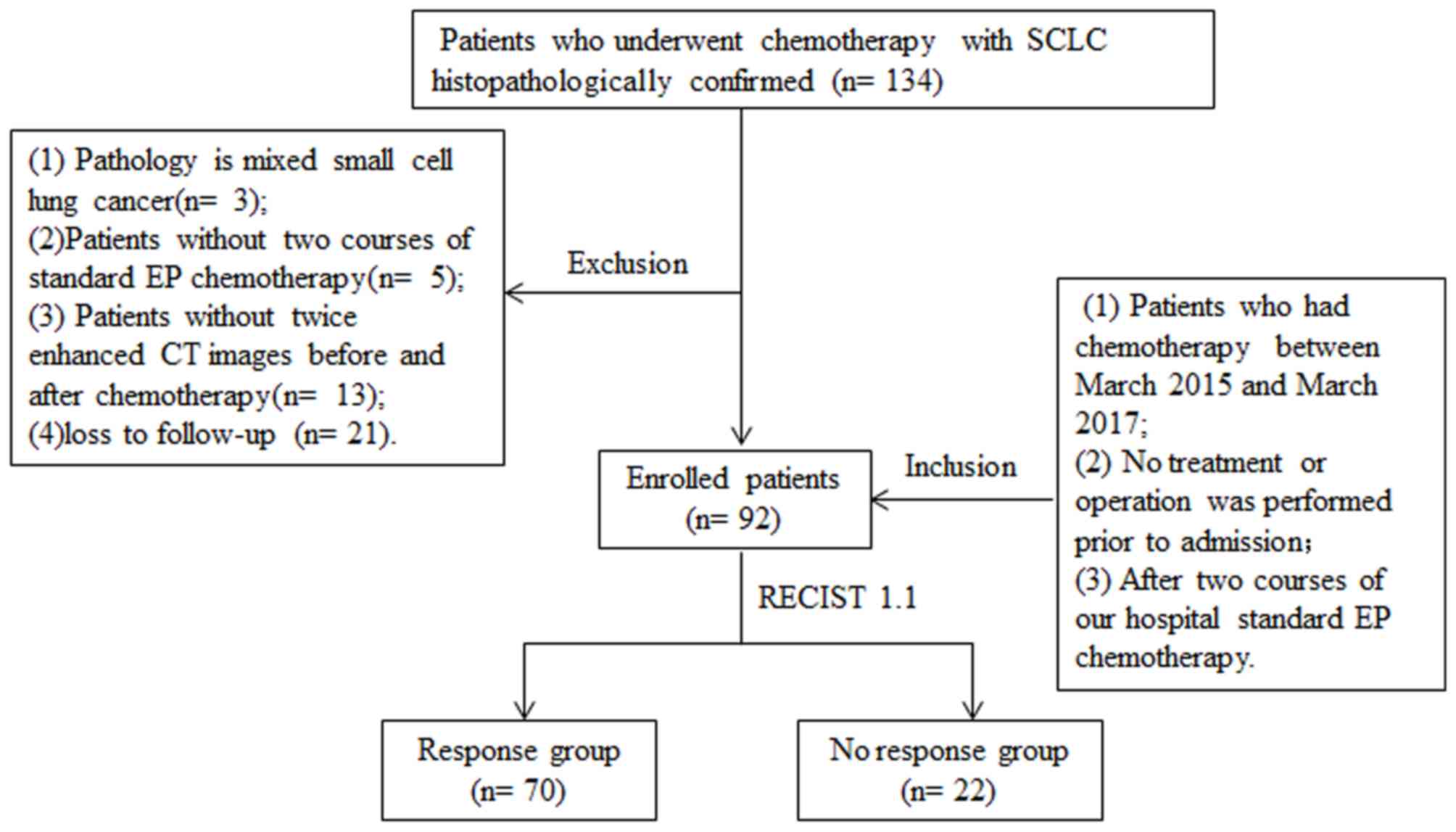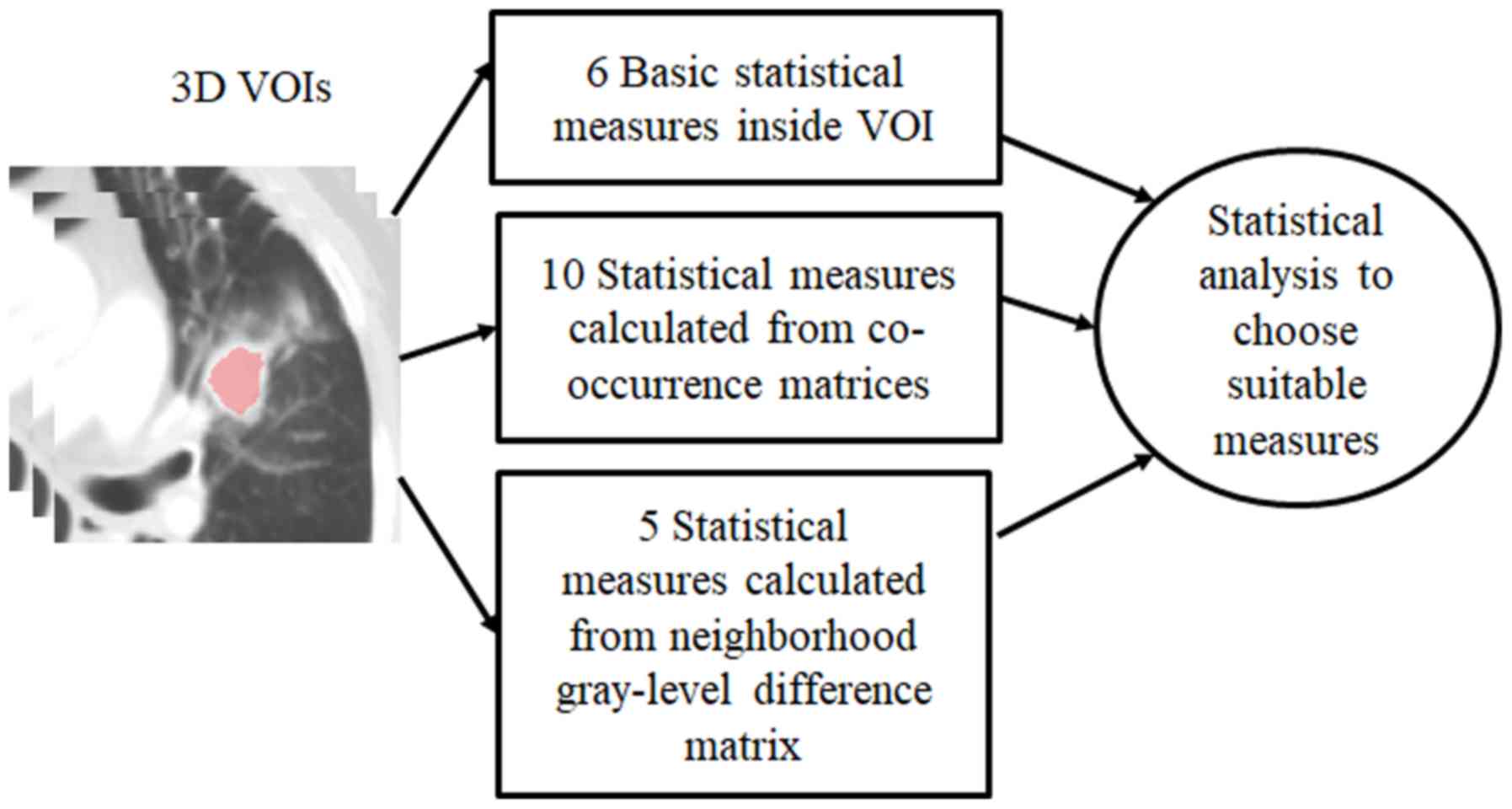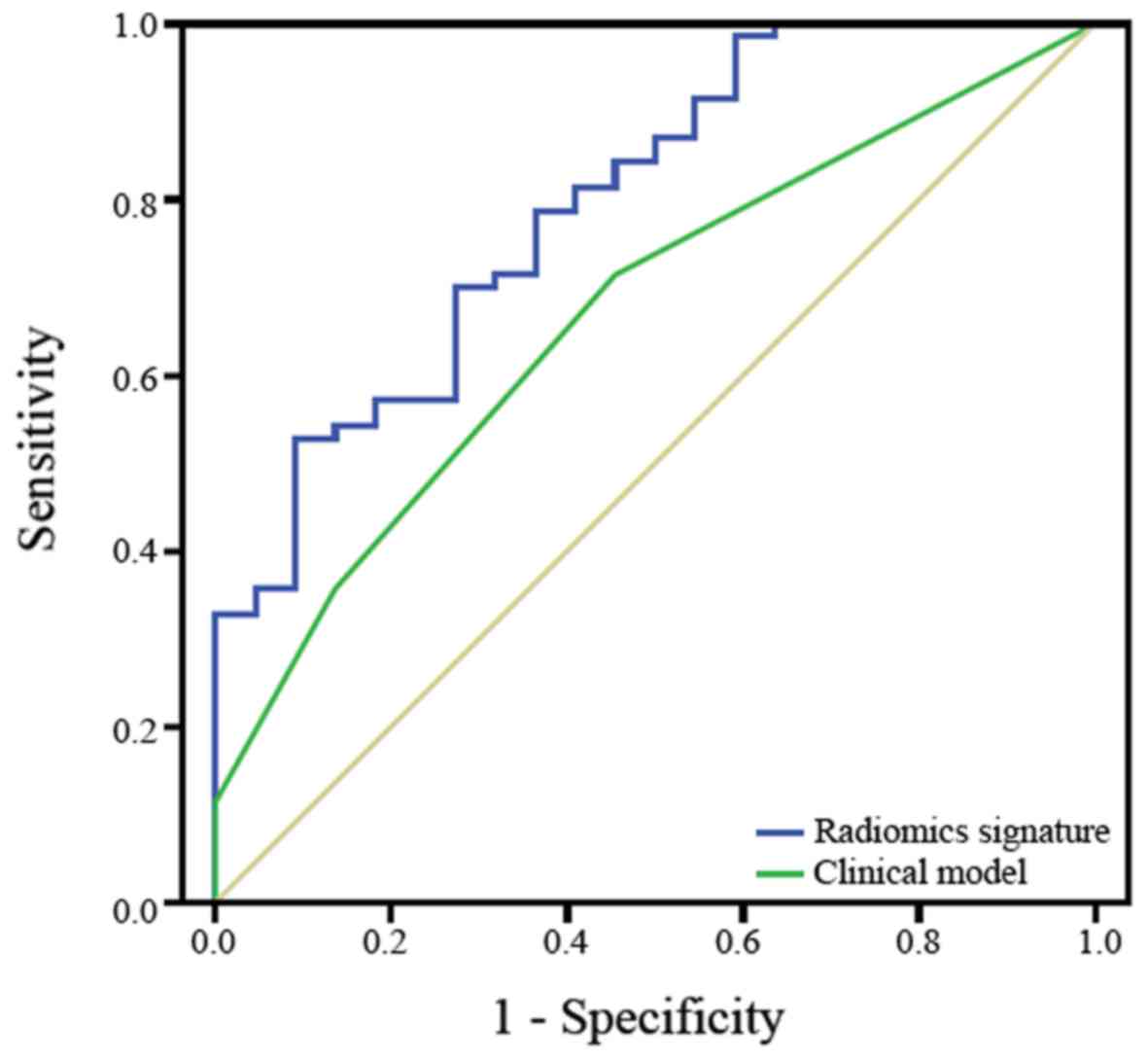|
1
|
Siegel RL, Miller KD and Jemal A: Cancer
Statistics, 2017. CA Cancer J Clin. 67:7–30. 2017. View Article : Google Scholar : PubMed/NCBI
|
|
2
|
Chen W, Zheng R, Baade PD, Zhang S, Zeng
H, Bray F, Jemal A, Yu XQ and He J: Cancer statistics in China,
2015. CA Cancer J Clin. 66:115–132. 2016. View Article : Google Scholar : PubMed/NCBI
|
|
3
|
van Meerbeeck JP, Fennell DA and De
Ruysscher DK: Small-cell lung cancer. Lancet. 378:1741–1755. 2011.
View Article : Google Scholar : PubMed/NCBI
|
|
4
|
Alvarado-Luna G and Morales-Espinosa D:
Treatment for small cell lung cancer, where are we now?-a review.
Transl Lung Cancer Res. 5:26–38. 2016.PubMed/NCBI
|
|
5
|
Bunn PA Jr, Minna JD, Augustyn A, Gazdar
AF, Ouadah Y, Krasnow MA, Berns A, Brambilla E, Rekhtman N, Massion
PP, et al: Small cell lung cancer: Can recent advances in biology
and molecular biology be translated into improved outcomes? J
Thorac Oncol. 11:453–474. 2016. View Article : Google Scholar : PubMed/NCBI
|
|
6
|
Polański R, Hodgkinson CL, Fusi A, Nonaka
D, Priest L, Kelly P, Trapani F, Bishop PW, White A, Critchlow SE,
et al: Activity of the monocarboxylate transporter 1 inhibitor
AZD3965 in small cell lung cancer. Clin Cancer Res. 20:926–937.
2014. View Article : Google Scholar : PubMed/NCBI
|
|
7
|
Sen T, Tong P, Stewart CA, Cristea S,
Valliani A, Shames DS, Redwood AB, Fan YH, Li L, Glisson BS, et al:
CHK1 inhibition in small-cell lung cancer produces single-agent
activity in biomarker-defined disease subsets and combination
activity with cisplatin or olaparib. Cancer Res. 77:3870–3884.
2017. View Article : Google Scholar : PubMed/NCBI
|
|
8
|
Ross JS, Wang K, Elkadi OR, Tarasen A,
Foulke L, Sheehan CE, Otto GA, Palmer G, Yelensky R, Lipson D, et
al: Next-generation sequencing reveals frequent consistent genomic
alterations in small cell undifferentiated lung cancer. J Clin
Pathol. 67:772–776. 2014. View Article : Google Scholar : PubMed/NCBI
|
|
9
|
Qiu YF, Liu ZG, Yang WJ, Zhao Y, Tang J,
Tang WZ, Jin Y, Li F, Zhong R and Wang H: Research progress in the
treatment of small cell lung cancer. J Cancer. 8:29–38. 2017.
View Article : Google Scholar : PubMed/NCBI
|
|
10
|
Lu HY, Wang XJ and Mao WM: Targeted
therapies in small cell lung cancer. Oncol Lett. 5:3–11.
2013.PubMed/NCBI
|
|
11
|
Hiltermann TJ, Pore MM, van den Berg A,
Timens W, Boezen HM, Liesker JJ, Schouwink JH, Wijnands WJ, Kerner
GS, Kruyt FA, et al: Circulating tumor cells in small-cell lung
cancer: A predictive and prognostic factor. Ann Oncol.
23:2937–2942. 2012. View Article : Google Scholar : PubMed/NCBI
|
|
12
|
Hou JM, Krebs MG, Lancashire L, Sloane R,
Backen A, Swain RK, Priest LJ, Greystoke A, Zhou C, Morris K, et
al: Clinical significance and molecular characteristics of
circulating tumor cells and circulating tumor microemboli in
patients with small-cell lung cancer. J Clin Oncol. 30:525–532.
2012. View Article : Google Scholar : PubMed/NCBI
|
|
13
|
Zhu LR, Li J, Chen P, Jiang Q and Tang XP:
Clinical significance of plasma fibrinogen and D-dimer in
predicting the chemotherapy efficacy and prognosis for small cell
lung cancer patients. Clin Transl Oncol. 18:178–188. 2016.
View Article : Google Scholar : PubMed/NCBI
|
|
14
|
Yang J, Jiao S, Kang J, Li R and Zhang G:
Application of serum NY-ESO-1 antibody assay for early SCLC
diagnosis. Int J Clin Exp Pathol. 8:14959–14964. 2015.PubMed/NCBI
|
|
15
|
Buil-Bruna N, López-Picazo JM,
Moreno-Jiménez M, Martin-Algarra S, Ribba B and Trocóniz IF: A
population pharmacodynamic model for lactate dehydrogenase and
neuron specific enolase to predict tumor progression in small cell
lung cancer patients. AAPS J. 16:609–619. 2014. View Article : Google Scholar : PubMed/NCBI
|
|
16
|
Gillies RJ, Kinahan PE and Hricak H:
Radiomics: Images are more than pictures, they are data. Radiology.
278:563–577. 2016. View Article : Google Scholar : PubMed/NCBI
|
|
17
|
Lambin P, Rios-Velazquez E, Leijenaar R,
Carvalho S, van Stiphout RG, Granton P, Zegers CM, Gillies R,
Boellard R, Dekker A and Aerts HJ: Radiomics: Extracting more
information from medical images using advanced feature analysis.
Eur J Cancer. 48:441–446. 2012. View Article : Google Scholar : PubMed/NCBI
|
|
18
|
Chen B, Zhang R, Gan Y, Yang L and Li W:
Development and clinical application of radiomics in lung cancer.
Radiat Oncol. 12:1542017. View Article : Google Scholar : PubMed/NCBI
|
|
19
|
Aerts HJ, Velazquez ER, Leijenaar RT,
Parmar C, Grossmann P, Carvalho S, Bussink J, Monshouwer R,
Haibe-Kains B, Rietveld D, et al: Decoding tumour phenotype by
noninvasive imaging using a quantitative radiomics approach. Nat
Commun. 5:40062014. View Article : Google Scholar : PubMed/NCBI
|
|
20
|
Fave X, Zhang L, Yang J, Mackin D, Balter
P, Gomez D, Followill D, Jones AK, Stingo F, Liao Z, et al:
Delta-radiomics features for the prediction of patient outcomes in
non-small cell lung cancer. Sci Rep. 7:5882017. View Article : Google Scholar : PubMed/NCBI
|
|
21
|
Wang H, Guo XH, Jia ZW, Li HK, Liang ZG,
Li KC and He Q: Multilevel binomial logistic prediction model for
malignant pulmonary nodules based on texture features of CT image.
Eur J Radiol. 74:124–129. 2010. View Article : Google Scholar : PubMed/NCBI
|
|
22
|
Ferreira Junior JR, Koenigkam-Santos M,
Cipriano FEG, Fabro AT and Azevedo-Marques PM: Radiomics-based
features for pattern recognition of lung cancer histopathology and
metastases. Comput Methods Programs Biomed. 159:23–30. 2018.
View Article : Google Scholar : PubMed/NCBI
|
|
23
|
Wu W, Parmar C, Grossmann P, Quackenbush
J, Lambin P, Bussink J, Mak R and Aerts HJ: Exploratory study to
identify radiomics classifiers for lung cancer histology. Front
Oncol. 6:712016. View Article : Google Scholar : PubMed/NCBI
|
|
24
|
Ganeshan B, Abaleke S, Young RC, Chatwin
CR and Miles KA: Texture analysis of non-small cell lung cancer on
unenhanced computed tomography: Initial evidence for a relationship
with tumour glucose metabolism and stage. Cancer Imaging.
10:137–143. 2010. View Article : Google Scholar : PubMed/NCBI
|
|
25
|
Coroller TP, Grossmann P, Hou Y, Rios
Velazquez E, Leijenaar RT, Hermann G, Lambin P, Haibe-Kains B, Mak
RH and Aerts HJ: CT-based radiomic signature predicts distant
metastasis in lung adenocarcinoma. Radiother Oncol. 114:345–350.
2015. View Article : Google Scholar : PubMed/NCBI
|
|
26
|
Fried DV, Tucker SL, Zhou S, Liao Z,
Mawlawi O, Ibbott G and Court LE: Prognostic value and
reproducibility of pretreatment CT texture features in stage III
non-small cell lung cancer. Int J Radiat Oncol Biol Phys.
90:834–842. 2014. View Article : Google Scholar : PubMed/NCBI
|
|
27
|
Gevaert O, Xu J, Hoang CD, Leung AN, Xu Y,
Quon A, Rubin DL, Napel S and Plevritis SK: Non-small cell lung
cancer: Identifying prognostic imaging biomarkers by leveraging
public gene expression microarray data-methods and preliminary
results. Radiology. 264:387–396. 2012. View Article : Google Scholar : PubMed/NCBI
|
|
28
|
Eisenhauer EA, Therasse P, Bogaerts J,
Schwartz LH, Sargent D, Ford R, Dancey J, Arbuck S, Gwyther S,
Mooney M, et al: New response evaluation criteria in solid tumours:
Revised RECIST guideline (version 1.1). Eur J Cancer. 45:228–247.
2009. View Article : Google Scholar : PubMed/NCBI
|
|
29
|
Ohno Y, Fujisawa Y, Koyama H, Kishida Y,
Seki S, Sugihara N and Yoshikawa T: Dynamic contrast-enhanced
perfusion area-detector CT assessed with various mathematical
models: Its capability for therapeutic outcome prediction for
non-small cell lung cancer patients with chemoradiotherapy as
compared with that of FDG-PET/CT. Eur J Radiol. 86:83–91. 2017.
View Article : Google Scholar : PubMed/NCBI
|
|
30
|
Zelen M: Keynote address on biostatistics
and data retrieval. Cancer Chemother Rep 3. 4:31–42.
1973.PubMed/NCBI
|
|
31
|
Huang X, Cheng Z, Huang Y, Liang C, He L,
Ma Z, Chen X, Wu X, Li Y, Liang C and Liu Z: CT-based radiomics
signature to discriminate high-grade from low-grade colorectal
adenocarcinoma. Acad Radiol. 25:1285–1297. 2018. View Article : Google Scholar : PubMed/NCBI
|
|
32
|
Haralick RM, Shanmugam K and Dinstein I:
Textural features for image classification. IEEE Trans Syst Man
Cybern. 3:610–621. 1973. View Article : Google Scholar
|
|
33
|
Kurani AS, Xu DH, Furst J and Raicu DS:
Co-occurrence matrices for volumetric data. Proceedings of the 7th
IASTED International Conference on Computer Graphics and Imaging.
CGIM. (Kauai, Hawaii). 447–452. 2004.
|
|
34
|
Amadasun M and King R: Textural features
corresponding to textural properties. IEEE Trans Systems Man
Cybern. 19:1264–1274. 1989. View Article : Google Scholar
|
|
35
|
Xu R, Kido S, Suga K, Hirano Y, Tachibana
R, Muramatsu K, Chagawa K and Tanaka S: Texture analysis on
(18)F-FDG PET/CT images to differentiate malignant and benign bone
and soft-tissue lesions. Ann Nucl Med. 28:926–935. 2014. View Article : Google Scholar : PubMed/NCBI
|
|
36
|
van Griethuysen JJM, Fedorov A, Parmar C,
Hosny A, Aucoin N, Narayan V, Beets-Tan RGH, Fillion-Robin JC,
Pieper S and Aerts HJWL: Computational radiomics system to decode
the radiographic phenotype. Cancer Res. 77:e104–e107. 2017.
View Article : Google Scholar : PubMed/NCBI
|
|
37
|
Pesch B, Kendzia B, Gustavsson P, Jöckel
KH, Johnen G, Pohlabeln H, Olsson A, Ahrens W, Gross IM, Brüske I,
et al: Cigarette smoking and lung cancer-relative risk estimates
for the major histological types from a pooled analysis of
case-control studies. Int J Cancer. 131:1210–1219. 2012. View Article : Google Scholar : PubMed/NCBI
|
|
38
|
Kang H, Lee HY, Lee KS and Kim JH:
Imaging-based tumor treatment response evaluation: Review of
conventional, new, and emerging concepts. Korean J Radiol.
13:371–390. 2012. View Article : Google Scholar : PubMed/NCBI
|
|
39
|
Chong Y, Kim JH, Lee HY, Ahn YC, Lee KS,
Ahn MJ, Kim J, Shim YM, Han J and Choi YL: Quantitative CT
variables enabling response prediction in neoadjuvant therapy with
EGFR-TKIs: Are they different from those in neoadjuvant concurrent
chemoradiotherapy? PLoS One. 9:e885982014. View Article : Google Scholar : PubMed/NCBI
|
|
40
|
Zhong Y, Yuan M, Zhang T, Zhang YD, Li H
and Yu TF: Radiomics approach to prediction of occult mediastinal
lymph node metastasis of lung adenocarcinoma. AJR Am J Roentgenol.
211:109–113. 2018. View Article : Google Scholar : PubMed/NCBI
|
|
41
|
Bogowicz M, Riesterer O, Ikenberg K, Stieb
S, Moch H, Studer G, Guckenberger M and Tanadini-Lang S: Computed
tomography radiomics predicts HPV status and local tumor control
after definitive radiochemotherapy in head and neck squamous cell
carcinoma. Int J Radiat Oncol Biol Phys. 99:921–928. 2017.
View Article : Google Scholar : PubMed/NCBI
|
|
42
|
Avanzo M, Stancanello J and El Naqa I:
Beyond imaging: The promise of radiomics. Phys Med. 38:122–139.
2017. View Article : Google Scholar : PubMed/NCBI
|
|
43
|
Ha S, Choi H, Cheon GJ, Kang KW, Chung JK,
Kim EE and Lee DS: Autoclustering of non-small cell lung carcinoma
subtypes on (18)F-FDG PET using texture analysis: A preliminary
result. Nucl Med Mol Imaging. 48:278–286. 2014. View Article : Google Scholar : PubMed/NCBI
|
|
44
|
Patil R, Mahadevaiah G and Dekker A: An
approach toward automatic classification of tumor histopathology of
non-small cell lung cancer based on radiomic features. Tomography.
2:374–377. 2016. View Article : Google Scholar : PubMed/NCBI
|
|
45
|
Zhou Y, He L, Huang Y, Chen S, Wu P, Ye W,
Liu Z and Liang C: CT-based radiomics signature: a potential
biomarker for preoperative prediction of early recurrence in
hepatocellular carcinoma. Abdom Radiol (NY). 42:1695–1704. 2017.
View Article : Google Scholar : PubMed/NCBI
|
|
46
|
Huang YQ, Liang CH, He L, Tian J, Liang
CS, Chen X, Ma ZL and Liu ZY: Development and validation of a
radiomics nomogram for preoperative prediction of lymph node
metastasis in colorectal cancer. J Clin Oncol. 34:2157–2164. 2016.
View Article : Google Scholar : PubMed/NCBI
|
|
47
|
Lee G, Lee HY, Park H, Schiebler ML, van
Beek EJR, Ohno Y, Seo JB and Leung A: Radiomics and its emerging
role in lung cancer research, imaging biomarkers and clinical
management: State of the art. Eur J Radiol. 86:297–307. 2017.
View Article : Google Scholar : PubMed/NCBI
|












